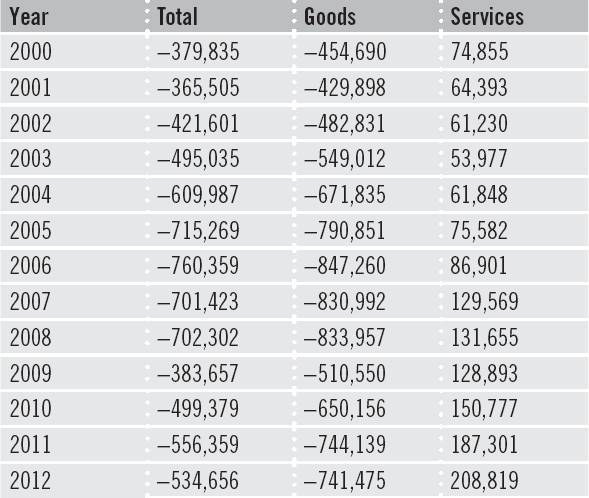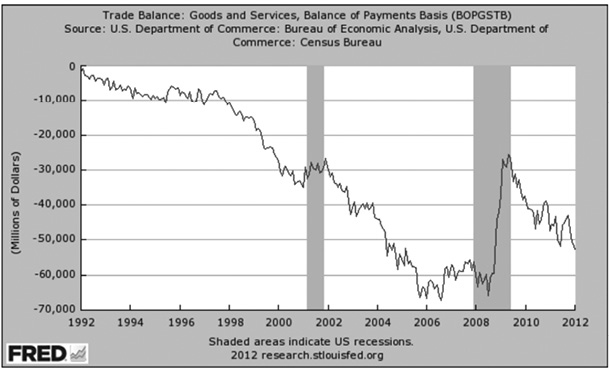The balance of trade is part of a bigger picture known as the current account, or balance of payments. Those figures, covered in the next entry, include not only the trade balance in physical goods and services but investments and other financial flows. When there is a trade deficit, it is often made up by financial flows—that is, how we pay our bills, although under current practice it leaves us in debt.
The trade deficit has grown substantially since 1997. Before that time, it ranged between $50 billion and $100 billion each year. It grew to almost $400 billion in 2000 and then to nearly $800 billion in 2006, as the prosperous American economy led to more imports of finished goods and raw materials. The Great Recession, combined with lower oil prices, an increase in domestic oil production, and expanding “export” of services, have all combined to attenuate the total trade deficit somewhat. The following table shows how the deficit has fluctuated over time:
Table 8.1 U.S. Balance of Trade 2000–2012 ($ Billion)

Source: U.S. Census Bureau
View a text version of this table
Long term, the balance of trade is affected by the strength of the U.S. and global economy. While a strong global economy would seem to help reduce the deficit by increasing exports, in practice it has tended to increase the deficit as Americans import more. That trend may change as America becomes more energy self-sufficient, but as you can see in Figure 8.1, the recovery has brought a return to higher deficits again—though not as high as prior to the Great Recession.
Figure 8.1 Balance of Trade, 1992–2012

Source: St. Louis Federal Reserve
Whether the U.S. trade deficit is good, bad, or ugly is still a matter of debate. The good news is that deficits have bounced off their lows, and imports in particular, led by energy, appear to be headed for a long-term decline. Even more good news is found in the fact that the deficit as compared to the size of the economy is still relatively modest by world standards. And every dollar spent overseas at least has the potential to come back to shore as something bought from the United States.
But today’s deficits are also a cause for major concern among economists and policymakers. First, they could well set new records again when the economy returns to health. Second, the gradual export of manufacturing capability to China and other nations suggests that the deficits may be structural and permanent and only likely to grow—although this trend has slowed lately. We just don’t have enough to sell into world markets. Third, our trading partners, again notably China, must finance the deficit through investments in U.S. securities, which only pushes the problem into the future.
Governments, notably the U.S. government, may want to reduce deficits, but attempts to control deficits through policy, tariffs, or taxation are notoriously difficult and usually have negative unintended consequences elsewhere in the economy (see #98 Protectionism). In fact, government policy to stimulate consumption (see #2) has the opposite effect. When the government sent tax stimulus checks in 2008, or reduced FICA taxes in 2011–2012, how much of that money do you suppose was spent to buy foreign cars or electronic gadgets?
When governments stimulate consumption, especially here in the United States, they inadvertently stimulate the deficit too. Countries that have lower consumption patterns (indicated by higher savings rates) typically have trade surpluses (again, China, but also Germany, Japan, and others). One of the best ways to lower the deficit is to stimulate savings—although this too can get out of hand and lead to deflation (see #19), as has been the case in Japan.
Why You Should Care
Just as you need to keep your own financial house in order, you should also be concerned about a nation that consumes more from abroad than it produces. It’s not a good thing over the long term. Not that you should or even can buy all of your goods from the United States, but all else being equal, a good or service sourced from the United States helps the economy, and one sourced from overseas hurts it.
96. BALANCE OF PAYMENTS AND CURRENT ACCOUNT
The balance of trade (covered in the previous entry) is part of a bigger trade picture. The balance of trade measures the flows of physical goods and services, and is a major component of the balance of payments. But the balance of payments goes further to measure the flow of payments—the financial flows—between countries. Thus, the flow of financial capital to purchase securities or to make foreign direct investments (see #94) is also included. It is a measure, at day’s end, of how much total worth or wealth is coming out of or going into our collective wallet.
What You Should Know
You’ll hear the term current account used frequently to determine where we are and where we are going. The current account is the sum of current activity from trade (imports and exports) and short-term financial flows like dividends and interest. The capital account—showing flows in favor of fixed asset investments and foreign direct investments—goes together with the current account to create the total balance of payments. Current account figures represent where we are short term with respect to international cash flows, and the current account deficit, like the trade deficit, gets a lot of attention from economists and policymakers.
Why You Should Care
Economists watch the balance of payments and the current account deficit or surplus to get the big picture on the health of the economy and the transfer of wealth from one nation to another. While knowing about the balance of payments may help you understand the evening news, it’s the balance of trade that’s truly important. As an individual, you can only affect the balance of trade through your consumption and saving decisions.
97. TRADE AGREEMENTS
Trade agreements, or trade “pacts,” are made between countries, usually multiple countries in a region, to remove trade barriers and to facilitate trade between them. The goals are to encourage trade, to achieve gains from comparative advantage, and to mutually benefit the economies of the pact members. Trade agreements achieve the same results as globalization (see #91), but usually on a smaller, more regional scale.
What You Should Know
A trade pact is a negotiated agreement between countries stipulating terms of import and export of some or all goods and services that might flow between them. Agreements usually cover tariffs and other taxes, and in some cases may contain social, environmental, or other stipulations governing trade in mutually beneficial ways. Most are “free” trade agreements, allowing free movement of goods and services across member borders. Critics of trade agreements follow the path of globalization critics, and typically work to include environmental, labor, and product safety requirements in the agreements.
For Americans, the largest and most significant trade agreement in recent years is the North American Free Trade Agreement (NAFTA). The agreement, ratified in 1994 between the United States, Canada, and Mexico, is the largest in the world measured by combined purchasing power. NAFTA opened borders for almost unrestricted movement of goods and services, subject to environmental rules consistent with U.S. policy. NAFTA led to the opening of large maquiladora (border zone) factories in Mexico to serve Mexican markets, boosting Mexican economic growth to a degree.